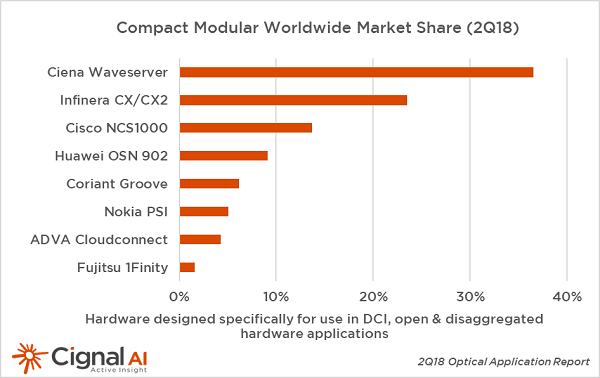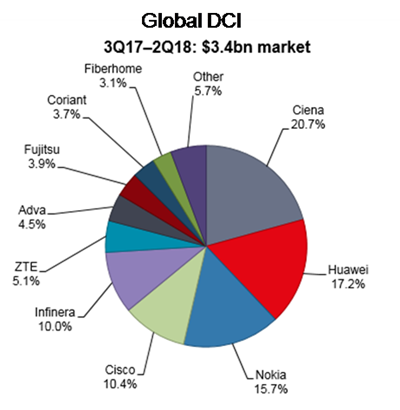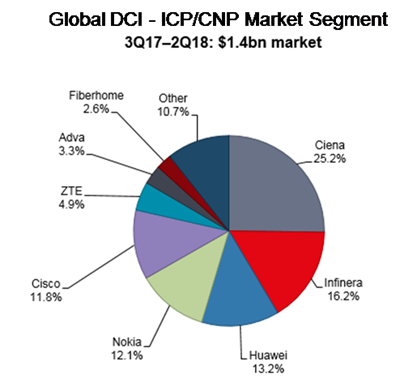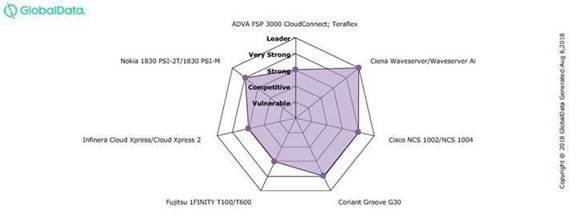5 Ways DCI Growth is Driving New Innovations in Transport Networking
Data center interconnect (DCI) is at the heart of new global business models, cloud adoption, and digital content delivery and services. Cloud, ICP, and colocation operators are dominating DCI sales, and DCI is becoming more crucial for other industries as well. According to the Equinix Global Interconnection Index, global interconnect bandwidth is forecast to grow to over 8,200T by 2021, which is substantially higher than last year’s projection.

Figure 1: Interconnect bandwidth growth through 2021 - Equinix
Telecommunications, manufacturing, and banking are all expected to be large contributors to total interconnect bandwidth by 2021. Smaller traffic areas, such as wholesale, retail, and healthcare, are also expected to grow at double-digit rates leading to the need for higher capacity services over time.
The result of this growth? Increased innovation.
Purpose-built, compact, modular systems have sprouted up, offering massive scalability to enable global deployments while reducing operational expenses related to data center space, power, and cooling. These systems offer modularity and pay-as-you-grow scalability for lower traffic scenarios, so enterprises can cost-effectively scale connectivity for cloud services and applications.
Ciena is the #1 market share leader in the compact modular optical equipment market for the second quarter of 2018, according to Cignal AI, and Ciena’s Waveserver Ai offers the capacity scalability and deployment simplicity needed to deliver a high performance, quality experience to end-user customers.

Figure 2: Cignal AI, Compact, modular DCI device market by Vendor/Product, Sep 2018
To enhance the scalability and performance of compact, modular DCI devices and improve platform openness while simplifying operations, new technologies and capabilities are being brought to market. Here are five new innovations being driven by DCI applications and capacity growth.
1. Next-generation coherent for any DCI application
DCI deployments are shifting out of the metro space into the long-haul and across the ocean to provide global content delivery as the ICPs build out comprehensive networks that span the globe. Now, purpose-built DCI platforms must incorporate next-generation coherent technology with higher baud modems to deliver more capacity at increased distances.
Next generation coherent interfaces offer higher capacity for DCI, enabling increased capacity for metro, regional and long-haul, or even subsea applications. DCI platforms with highly programmable coherent interfaces can be deployed in the metro, enabling up to 400G per wavelength, to double capacity when compared to 200G systems. For long-haul applications, where wavelengths were previously limited to 100G, operators can now upgrade these links to 200G; on regional links previously limited from 150G to 200G, operators can now attain capacities of 300G. These interfaces can also be used to supply up to 100G per wavelength on longer pan-Pacific subsea links and up to 200G per wavelength across shorter subsea links. Platforms like Ciena’s Waveserver Ai maximize capacity for any distance application, closely matching capacity to available system margin.
2. Increased fiber capacity with L-band
For DCI operators with limited access to fiber or who are experiencing dramatic traffic growth rates, increasing per wavelength capacity is not enough, so network operators are expanding into the L-band to double the capacity per fiber. This is especially important for subsea DCI networks, where the cost of laying subsea cable is high. But, it is also being considered for some terrestrial networks. Modern DCI platforms must have the ability to scale capacity in both the C-band and L-band to maximize return on the fiber plant investment.
3. New levels of software openness
DCI network operators also want the choice to manage their networks in a way that fits with their operational model. As a result, purpose-built DCI platforms have embraced simplicity and openness, offering management through open APIs or more traditional management and service lifecycle software platforms, like Ciena’s Blue Planet Manage, Control and Plan (MCP).
Open APIs can simplify integration into existing management back-office systems and can enable new ways to configure and monitor the network through capabilities such as declarative configuration and streaming telemetry. Openness is now moving to the software components running on the network elements themselves – giving the flexibility to pick and choose software modules and paving the way for supporting 3rd party software components as well.
4. Secure interconnect with L1 encryption
As data in the cloud travels across fiber networks between different data centers, security is an important concern. Layer 1 transport encryption is available on modern DCI products, enabling bulk encryption of all in-flight data between data centers. Layer 1 encryption uses secure AES-256 cryptography directly from the optical DCI platform to provide full-throughput transmission without traffic congestion. It simplifies the security architecture and reduces costs associated with managing and deploying separate, higher layer encryption appliances. Layer 1 encryption reduces the risk of data breach and the associated regulatory fines by safeguarding sensitive data and confidential records that are carried across DCI networks.
5. On-demand connectivity with service orchestration
Enterprises, as well as, service providers are turning to service orchestration to optimize hybrid-cloud and multi-cloud architectures for cloud interconnect applications. Service orchestration platforms, such as Ciena’s Blue Planet Multi-Domain Service Orchestration (MDSO), allow customers to customize and dynamically adjust their capacity across interconnect links to cloud providers. Multi-domain service orchestration accelerates service delivery and improves the end-user experience of the enterprise. It also alleviates network complexity and increases automation across hybrid or multi-cloud networks.
Ciena – an innovative partner you can trust for DCI
Ciena has more experience with high-capacity interconnect networks than any other vendor in the DCI market today. Ovum ranks Ciena #1 in global data center interconnect, with over 20% market share, and ranks Ciena #1 in the ICP segment, with 25% market share for the rolling four quarter period from 3Q17 to 2Q18.


Figure 3: Ovum, Global DCI and ICP DCI Market Share Report, Aug 2018
Ciena’s proven DCI solutions and leading innovation track record, combine to take the risk out of DCI, and Ciena’s purpose-built DCI hardware platforms have been deployed in over 100 networks globally. Ciena offers the greatest scalability and simplifies DCI with easy to deploy solutions, such as the Waveserver family, that use a server-like deployment model with rack-and-stack scalability, just like a typical storage or compute server.
GlobalData’s recent DCI competitive landscape assessment gave Ciena’s Waveserver Ai the highest ranking in the industry for compact, modular DCI products (see chart below). It is the only product to achieve the “Leader” ranking, highlighting its industry leading capacity and density. Waveserver Ai incorporates Ciena’s next-generation coherent technology, WaveLogic Ai, to offer programmability from 100G to 400G in 50G increments to fine-tune capacity and maximize fiber utilization for any distance application.

Figure 4: GlobalData, DCI Competitive Landscape Assessment, Aug 2018
Keep in mind bandwidth is going to continue to grow and DCI needs will evolve… do you have a partner that can innovate to meet changing market requirements? De-risk your DCI and alleviate the complexity associated with modernizing your interconnect network with a partner who has a proven track record for innovation - Ciena.




